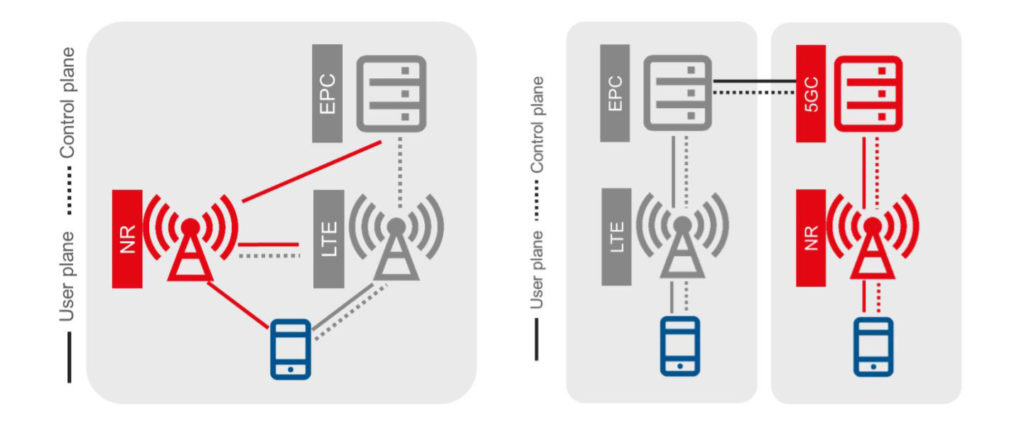Recently, the country’s largest telecom company Reliance Jio has announced the launch of 5G services in Delhi, Mumbai, Kolkata and Chennai by Diwali. It has been said by the company that it will use ‘standalone 5G’ architecture to provide the service.
Worldwide 5G networks are being established in two modes – ‘standalone 5G’ and non-‘standalone 5G’
What is the difference between “standalone 5G” and “non-standalone 5G”?
- SA (standalone) options include only one generation of radio access technology and NSA (non-standalone) includes two generations of radio access technologies (4G LTE and 5G).
- Standalone 5G does not rely on LTE EPC to operate, but instead it connects the 5G radio to the cloud-native 5G core network.
- The main difference between NSA (non-standalone architecture) and SA (standalone architecture) is that NSA connects the control signaling of 5G radio networks to the 4G core while SA connects the 5G radio networks directly to the 5G core network.
- NSA, as the name suggests, is a 5G service that is not ‘stand alone’ but built on existing 4G networks. On the other hand, SA allows independent operation of 5G services directly using existing 4G cores.

IMAGE FROM GSMA
What is 5G?
- 5G is a wireless telecommunication technology. In this, radio waves and radio frequency (RF) are used for data transmission and reception.
- It is the next generation of mobile network technology after 4G LTE network. The use of 5G technology was gradually introduced in services in early 2019 and will be expanded to full services by 2024.
- The final standard for 5G will be set by the International Telecommunication Union (ITU).
Features of 5G
- High data rates (1Gbps for hotspots, 100Mbps download speed and 50Mbps upload speed for wide-area coverage).
- Broad connectivity (1 million connections per square kilometer area)
- Ultra-low-latency (1 millisecond)
- High reliability (99.999% for mission critical “ultra-reliable” communications).
- Mobility at high speeds (up to a speed of 500 km/h ie for high-speed trains).
Benefits of 5G
- Fast Internet Speed – Currently 4G networks are capable of achieving a maximum download speed of one gigabyte per second. With 5G, this speed can be increased to 10 gigabytes per second.
- Ultra-low-latency – Latency refers to the time it takes to send a data packet from one device to another. The latency rate in 4G is 50 milliseconds while in 5G it can be up to 1 millisecond.
- Well-connected world – 5G will provide capacity and bandwidth as per user requirement to accommodate technologies such as Internet of Things. Thus it will help in the adoption of Artificial Intelligence.
- According to the Organization for Economic Co-operation and Development (OECD) Committee on Digital Economic Policy, the implementation of 5G technology will help increase GDP, create jobs and digitize the economy.
Benefits from 5G
- The cumulative economic impact of 5G on India could reach one trillion US dollars by 2035. It will help in incorporation of Artificial Intelligence into our lives and enable seamless data exchange across smart devices to provide an environment for Internet of Things (IoT).
- 5G can enable improvements in the entire value chain, from agriculture to smart irrigation, better soil and crop monitoring, and livestock management.
- 5G will enable the use of robotics for precision manufacturing, particularly where humans cannot perform these tasks safely or accurately.
- In the energy sector, “smart grid” and “smart metering” can be supported.
- In healthcare, 5G could enable more effective remote-medicine delivery, remote control of surgical robotics, and wireless monitoring of vital data.
Challenges with Standalone 5G Services
Inistalling new antennas is very challenging. Such as buildings, trees, bad weather etc. can also become a cause of obstruction. Hence there is a need to build more base stations for better connection.
Now overall, a separate infrastructure will have to be created for Standalone 5G, that is, separate towers will be installed for it, so Jio has introduced Jio AIRFIBER for 5G coverage in homes and offices. The company that will provide the service of Non-Standalone 5G will also be able to provide services without installing a separate tower. However, Vodafone Idea and Airtel have not said anything about the coverage of 5G yet. It is possible that the other two companies will also expose Standalone 5G. You should know that when 4G connection came in India, the situation was same. 4G services was expended on 3G infrastructure.
Read all articles here : Science Notes for UPSC